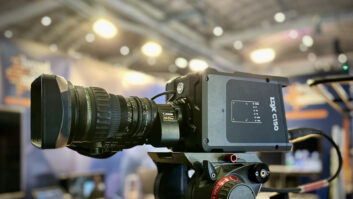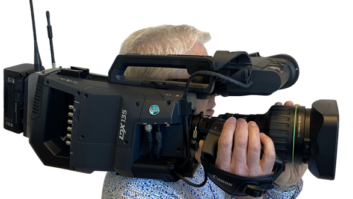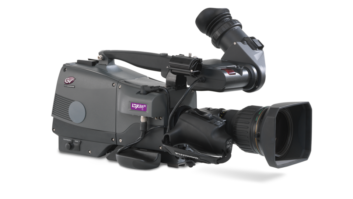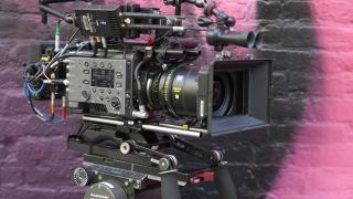
Hi-motion innovation from I-Movix, P+S, Vision Research and Weisscam, by David Fox.
I-Movix has introduced three new high-speed cameras this year. Its SprintCam V3 HD features frame rates of 500 to 1,000 fps with instant replay. It “brings the outstanding usability and quality benefits of the SprintCam platform to customers requiring a specifically HD-native system,” said Laurent Renard, CEO of I-Movix. “The outstanding image quality produced, combined with complete ease-of-use, means V3 HD is a superb answer for slow-motion requirements in sports broadcasting, commercials production, documentaries, and movies.”
The system comprises a high-speed HD 1920×1080 single CMOS sensor camera, an operational control panel, a slow motion remote, and the camera control unit (outputting HD-SDI 1080i), and can work with an EVS LSM server for sequence storage, or with any SDI recorder.
Its SprintCam Basic is an entry-level slow-motion system with frame rates of 500 to 2,000 fps with instant replay in SD resolution. It doesn’t have the full broadcast integration of the SprintCam Live and SprintCam HD systems, but it does promise good light-sensitivity, a user-friendly interface, and out-of-the-box operation with no requirement for special training.
The I-Movix SprintCam Live V2.1 can capture from 500 to 10,000fps for instant replay at SD resolutions (there are three versions – up to 1,000fps, 3,000fps and 10,000fps). This latest update boasts improved image quality, new user-friendly remote controls that enable fine-tuned settings, and a slow-motion remote with a new cueing system that allows a quick and easy selection of the sequence to replay.
I-Movix has traditionally worked with Fujinon for its lenses, but its SprintCam Live V2.1 and SprintCam V3 HD are now also certified for use with the Canon Digisuper86Ⅱxs XJ86x9.3B IEⅡ-D for sports and live events broadcasting.
Faster than a speeding bullet
Vision Research’s new Phantom v710 is “the world’s fastest CMOS-based digital camera, with a maximum recording speed of 1.4 million fps” thanks to its throughput of more than seven gigapixels-per-second, allowing it to record at 7,530fps at its maximum resolution of 1280×800. It only reaches its top frame rate at much reduced resolutions, but for broadcast it would probably be used at 720p, where its top speed is 8,360fps.
Its Dual HD-SDI output is useful for broadcast users, who can simultaneously feed replays to the OB truck while still viewing and capturing new footage. The colour version of the CMOS sensor is rated at ISO 1,600, while a monochrome version is ISO 6,400.
For higher definition use, the new Phantom v640, four-megapixel digital high speed camera, boasts six gigapixel-per-second throughput, plus recording speeds of greater than 1,400fps at its full-resolution of 2,560×1,600, with less resolution up to its maximum frame rate of 300,000fps. At 1,920×1,080 it can range from 10fps to over 2,700fps.
The new CMOS sensor design significantly boosts its sensitivity by using micro lenses for each pixel. It is available with either a colour (ISO 1,000) or monochrome (ISO 4,000) CMOS sensor, supporting both an 8-bit pixel depth, for longer record times and smaller file sizes, and 12-bit pixel depth, for extra detail and clarity. It also features Extreme Dynamic Range, which allows users to capture two different exposures within a single frame.
With its internal shutter mechanism, users can perform a session-specific black reference (remotely) without having to physically cover the lens. Without this calibration colours can alter and images be poorly exposed as the sensor’s pixels drift from one exposure to the next.
It comes with 8GB, 16GB or 32GB of RAM, and can record to Vision Research’s CineMag hot-swappable memory magazine (128GB, 256GB or 512GB), which can directly record up to 250fps (490fps in HD) sequences for long record times. The onboard memory allows higher speed recording, with later transfer to the CineMag. The v640 includes Dual HD SDI output.
At the budget end, the Phantom v310 has a top speed of 3,400fps at its highest resolution (1280×800), but can record at speeds up to 500,000fps at much lower resolutions. It uses a proprietary, wide aspect CMOS sensor (compared to SD SprintCams, which use a square 1024×1024 sensor) that is available in colour or monochrome, with good light sensitivity and exposure times as short as one microsecond.
The entry-level Phantom v210 has the same megapixel resolution as the v710, but two gigapixel-per-second throughput for a maximum frame rate of over 2,000fps at full resolution, up to 300,000fps at lower resolutions. It has twin HD-SDI outputs,
It has also updated its Phantom HD to the HD Gold, which features a digital cinema optimised CMOS imaging sensor, new firmware and software It “was developed using direct feedback from existing Phantom HD users and incorporates new technologies which boosts performance and makes it easier and more efficient to use,” said Kamran Firooz, VP and general manager of Vision Research.
It shoots 555fps at its maximum resolution of 2048×2048, more than 1,000fps at 1920×1080, and at least 1,500fps at 1280×720. Users can adjust the frame rate in increments of one frame per second in HD resolution. It offers 35mm field-of-view and depth-of-field at both HD and 2K resolutions. More than 100 Phantom HD cameras have been sold, and these will be upgradeable with new hardware, including the new CMOS chip and new cooling technology.
Trigger happy
The portable, battery-powered Phantom Miro has been updated to the new Miro eX-Series: three models, the 640×480 eX1 and eX2, and the 800×600 eX4, which can record up to 1,200fps at full resolution, and to more than 100,000fps overall, plus exposure times as low as 1/500,000 second.
All controls are accessed via the Miro eX’s 3.5-inch touch-screen LCD, so it doesn’t need a computer, including basic editing functions. The eX2 and eX4 also have a built-in, Image-Based Auto-Trigger, which starts recording as soon as motion is detected within a specific point in the frame. Prices start from $10,000.
The Weisscam HS-2 high-speed camera can shoot at up to 1500 frames per second in 2K, 2000fps in 1080p, or up to 4000fps in 720p, using a full-size Super35 CMOS Sensor with a global shutter, and record uncompressed.
Users can shoot in HD or RAW modes, or both. The HD stream offers YCbCr in 4:2:2 or 4:4:4, and users can choose between linear standard curves like ITU-R 709 or a log curve for a higher contrast range within the HD-SDI image. The RAW stream is a 12-bit uncompressed Weisscam RAW file and offers the freedom to debayer in post. It has a fast boot-up time that makes it ready to shoot in less than seven seconds.
For recording, the add-on DigiMag DM-2 is an uncompressed, compact HD-SDI single and dual link recorder, which can also work with other digital cinema cameras such as the Arriflex D21, Sony F35, Grass Valley Viper, Phantom HD or standard HDTV cameras (like Sony’s F900). The external Weisscam DeBayerBox can do real-time debayering of the stored RAW data on the DM-2, outputting a standard HD YCbCr.
The camera was developed by Weisscam and P+S Technik. Its PL lens mount accepts 35mm lenses like Cooke S4s, but the Interchangeable Mount System from P+S Technik means users could attach almost any lens.
“The fact that the camera doesn’t need a computer on the set anymore quite simplifies working with it. The operator is able to check every adjustment concerning the camera and the recorder with the HU-2 HandUnit.” explained Stefan Weiss, DoP and developer. The optional HU-2 can fully control the camera and image processing and can be connected by cable or wireless.
www.i-movix.com
www.pstechnik.de
www.visionresearch.com
www.weisscam.com







